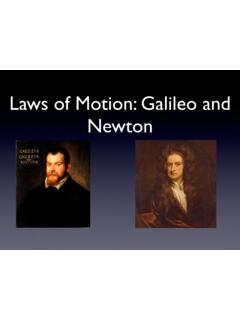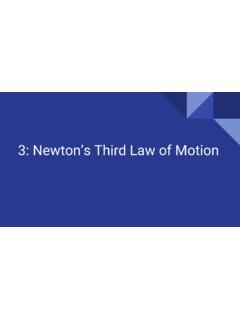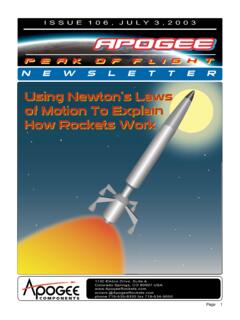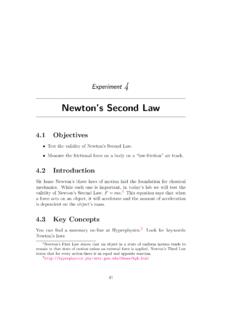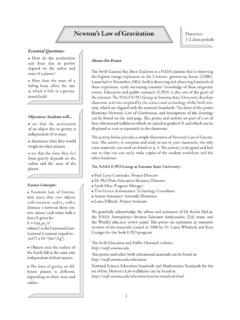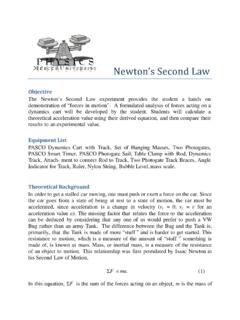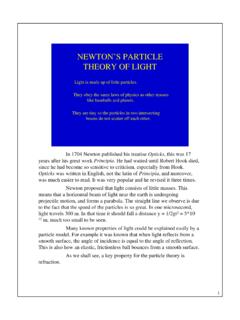Transcription of Activity Demonstrating Newton’s Laws of Motion Burleson
1 Activity Demonstrating newton s laws of Motion Burleson Version: April 2012 1 Demonstrating newton s laws of Motion Subject Area(s): Physics, Physical Science Associated Unit Associated Lesson: Demoing Through newton s laws of Motion Activity Title : Demonstrating newton s laws of Motion Insert Header Here (Centered) Grade Level: 9 (9-12) Activity Dependency: See associated lesson Time Required: 45 Minutes Group Size: 6 Expendable Cost per Group: US $2 Image 1 Image file: ADA Description: An image of a contemporary painting of Sir Isaac newton Source/Rights: Copyright 2005 Wikimedia Commons Caption: None Activity Demonstrating newton s laws of Motion Burleson Version: April 2012 2 Summary: The goal of this Activity is to provide an understanding of newton s laws through a series of demonstration (3 total). Students are given the material and procedure and are encouraged to answer hypothesize, record results, and make real world connections to the demonstrations they perform.
2 Engineering Connection: newton s laws are the basis for engineering, movement and the interaction that engineers and scientist have to think about in every design and idea. Understanding how these laws work, just like any scientific law, is the first step in being able to apply it to engineering problems. Once these laws are understood they can be applied to a multitude of problems relating to mechanical engineering (brake system in cars), electrical engineering (accelerometer), and civil engineering (sediment transport). Engineering Category: 1. Relating science and/or math concept(s) to engineering Keywords newton s Law, Motion , force, accelerometer, acceleration, sediment transport, brakes Educational Standards: International Technology and Engineering Educators Association (ITEEA) Standards ITEEA, Standard 5, Grades 9-12, I. With the aid of technology, various aspects of the environment can be monitored to provide information for decision-making.
3 ITEEA, Standard 11, Grades 9-12, N. Identify criteria and constraints and determine how these will affect the design process. Texas Essential Knowledge and Skills (TEKS) Grade 9-12 [2010] - Physics (2) Scientific processes. The student uses a systematic approach to answer scientific laboratory and field investigative questions. The student is expected to: (C) know that scientific theories are based on natural and physical phenomena and are capable of being tested by multiple independent researchers. Unlike hypotheses, scientific theories are well-established and highly-reliable explanations, but may be subject to change as new areas of science and new technologies are developed; (3) Scientific processes. The student uses critical thinking, scientific reasoning, and problem solving to make informed decisions within and outside the classroom.
4 The student is expected to: (D) explain the impacts of the scientific contributions of a variety of historical and contemporary scientists on scientific thought and society; Activity Demonstrating newton s laws of Motion Burleson Version: April 2012 3 (3) Scientific processes. The student uses critical thinking, scientific reasoning, and problem solving to make informed decisions within and outside the classroom. The student is expected to: (E) research and describe the connections between physics and future careers; Pre-Requisite Knowledge Conservation of momentum, understanding of newton s laws of Motion , relative Motion Learning Objectives After this Activity , students should be able to: Describe the first step in research/engineering process Identify which of newton s laws applies to each demonstration Identify one example of how this law is important in engineering and design Materials List The material list below is the total needed for one attempt at each demonstration.
5 The material list should be multiplied appropriately depending on how many times the demonstration is done Demonstration (Station) #1 Weighing Down A Can One soda can (empty) 10 lb weight Brake Pad Demonstration (Station) #2 Ball in a Box Box (clear with closable top) Tennis ball String Duct tape Wii remote Rubber Band Demonstration (Station) #3 Bouncing Balls 1 Basketball 1 tennis balls Water Sand (large and variety of grain size) Plastic tub Introduction / Motivation The first step in any engineering design is to understand what you are working with and be able to demonstrate these laws . When researchers and engineers begin creating model to understand how fluid flows in a river or how to design the most efficient car or airplane, the first step is to write down the governing equations and principles. What laws or principles did we just discuss?
6 (See Associated Lesson). You are going to take the first step in the engineering design process and present your understanding of newton s laws of Motion by doing demonstrations that use the three laws . Activity Demonstrating newton s laws of Motion Burleson Version: April 2012 4 Vocabulary / Definitions (Note: Same as Associated Lesson) Word Definition newton s First Law of Motion An object at rest stays at rest and an object moving at a constant velocity, continues at that velocity unless acted upon by a net force. newton s Second Law of Motion Force equals mass times acceleration newton s Third Law of Motion For every action there is an equal and opposite reaction. Brake Pads A component of a disk brake that is used to grind and slow a its Motion Accelerometer A device that measures acceleration Sediment Transport The movement of sediment due to forces from gravity and water.
7 Background If it is not already visible from the associated lesson, write down each of newton s laws of Motion so that the students can refer to it or have them refer to their notes from the associated lesson. All the background information is covered in the associated lesson (Demoing Through newton s laws ) Procedure: Before the Activity (Setup) 1) Gather materials for each demonstration and place in different areas in the classroom 2) For demonstration #1: a) Place the weight on a sturdy table and the empty cans and brake pad in a bin or bag next to the table. 3) For Demonstration #2 a) Wrap the rubber band around the tennis ball. b) Take the string loop it underneath the rubber band. c) Make the length of the string allows the ball to barely touch the bottom of the box. d) Use duct tape to hold down the string outside the box so that it is hanging inside the box and just touch the bottom.
8 4) For Demonstration #3 a) Place balls in bag or on table for students to grab b) In a plastic tub (or sink if available), Place sand (1-inch thick) over half of the area and put water (1/2 inch thick) in the other area. 5) Make copies of the procedural documents for each station and place one at each demonstration area 6) Make copies of the worksheet and distribute as students enter the room. As an entire class: 1. Split the class into three groups. 2. Explain that each station has 15 minutes then will rotate to the next station. 3. Explain the rotation. Station 1 goes to Station 2. Station 2 goes to Station 3. Station 3 goes to Station 1. Activity Demonstrating newton s laws of Motion Burleson Version: April 2012 5 4. Make sure to record the necessary information on the worksheet at each station for a discussion at the end of the class.
9 It is important for each group to identify each of newton s laws that are present for each demonstration. Station #1: Weighing Down a Can Insert Image #2 here (left justified next to procedure for this station) 1. What will happen when you place the weight on top of an empty can? Answer question on worksheet. 2. Place an empty can on the table. 3. Carefully balance the weight on top of the can. 4. Record what happen. Which of newton s laws applies? Answer question on worksheet. 5. What will happen if you drop the weight on top of an empty can? Answer question on worksheet. 6. Place an empty can on the table. 7. Hold the weight directly over the can about two feet high. 8. Drop the weight 9. Record what happen. Which of newton s laws applies? Answer question on worksheet. 10. Look at the brake pad (Image 2). How does the law presented in this demonstration relate to how a brake pad works?
10 Answer question on worksheet. 11. Place crushed can in recycling and return items to original location. Image 2 Image file: ADA Description: This is an image shows how a brake pad works. Source/Rights: Copyright 2010 Amm105 at WikiCommons Caption: Using the concept presented in the state, brake pads help your car stop or slow down. Activity Demonstrating newton s laws of Motion Burleson Version: April 2012 6 Station #2: Ball in a Box Insert Image #3 here (left justified next to procedure for this station) 1. With the box sitting still on the table, what is the ball exerting on the bottom of the box? Answer question on worksheet. 2. What will happen to the hanging tennis if you move the box quickly to the right? Answer question on your worksheet. 3. Pick up the box and hold it waist high. 4. Allow the ball to become steady then quickly move the box to the right. 5. What did the ball exhibit on the side of the box?

